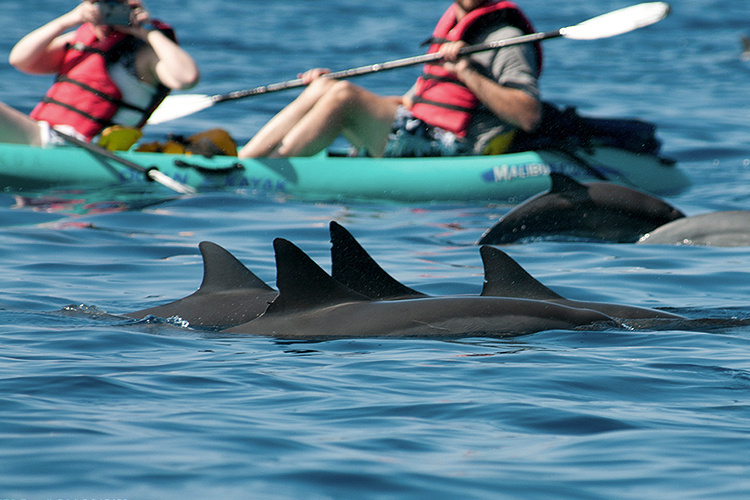New Federal Rule: Stay 50 Yards away from Hawaiian Spinner Dolphins

Today, NOAA Fisheries finalized a rule authorized under the Marine Mammal Protection Act that prohibits swimming with, approaching or remaining within 50 yards of a Hawaiian spinner dolphin.
NOAA Fisheries also is proposing to establish time-area closures to reduce disturbance in five nearshore areas designated as essential daytime habitats for spinner dolphins.
The new federal rule to remain 50 yards (half a football field) from spinner dolphins applies to any vessel, person or object (including all boats, canoes, stand-up paddleboards, drones or any other means) that is within 2 nautical miles from shore in the main Hawaiian Islands and in designated waters bounded by the islands of Lāna‘i, Maui and Kahoʻolawe.
The rule also prohibits approach by “interception” or placing a vessel, person or other object in the path of a spinner dolphin so that the dolphin approaches within 50 yards of the vessel, person or object.
Like all animals, Hawaiian spinner dolphins need rest. Spinner dolphins are nocturnal feeders that perform critical resting behaviors during the day while in safe, nearshore areas. But for decades, spinner dolphins in Hawaiʻi have experienced intense viewing pressure from commercial and recreational wildlife viewers seeking close encounters with the charismatic marine mammals.
This final rule takes effect Oct. 28, 2021, 30 days after it was published in the Federal Register.
There are eight exceptions to the prohibitions listed in this regulation, summarized below:
- People who inadvertently come within 50 yards of a Hawaiian spinner dolphin or are approached by a spinner dolphin, provided they make no effort to engage or pursue the animal and take immediate steps to move away from it
- Vessels that are underway and approached by a spinner dolphin, provided they continue normal navigation and make no effort to engage or pursue the animal
- Vessels transiting to or from a port, harbor or in a restricted channel to maintain safe navigation when a 50-yard distance will not allow the vessel to maintain safe navigation
- Vessel operations necessary to avoid imminent and serious threats
- Vessels that are anchored or aground and approached by a spinner dolphin, provided the vessel makes no effort to engage or pursue the animal
- People or vessels conducting activities authorized through a NOAA Fisheries permit or authorization
- Government vessels and personnel conducting official duties
- Commercial fishing vessels that incidentally “take” a spinner dolphin during normal fishing operations, provided that they operate legally according to the Marine Mammal Protection Act
NOAA Fisheries proposal to establish five time-area closures would prohibit entering restricted areas between 6 am. and 3 pm daily in La Perouse Bay on Maui, Makako Bays on Hawai‘i Island, and parts of Kealakekua, Hōnaunau and Kauhakō (Ho‘okena).
Since this is a proposed rule, a decision on whether to finalize the rule will not happen until after the public has an opportunity to comment. The public comment period for the proposed time-area closures will be open until Dec. 27, 2021, 90 days after publication in the Federal Register.
There are six proposed exceptions to the time-area closure prohibitions, summarized below:
- Vessel operations necessary to avoid an imminent and serious threat
- Activities authorized through a NOAA Fisheries permit or authorization
- Government vessels and personnel conducting official duties
- Vessels transiting straight through the area that are participating in organized canoe races
- Vessels transiting straight through the closures to access privately owned property adjacent to the restricted areas
- Outrigger canoes used for traditional subsistence fishing
Why Are These Rules Necessary?
Spinner dolphins are nocturnal and hunt in offshore waters at night. During the day, they use areas close to shore that have optimal environmental conditions to socialize, nurture their young, shelter from predators, and rest in preparation for nightly hunting. These specific areas are considered spinner dolphin essential daytime habitats.
Spinner dolphins disturbed during this crucial period may engage in avoidance or distress behaviors. And a lack of consistent, undisturbed resting periods can reduce the amount of energy they have for hunting and caring for their young. Chronic exposure to human activities in their daytime essential habitat may place resident populations of spinner dolphins at risk through habitat displacement or reduced health.
Even though spinner dolphins can simply “swim away” from people or vessels if they are disturbed, doing so interrupts their rest. It keeps them in a state of vigilance, and forces them to expend energy to increase their swimming speed and/or change direction. This energy expenditure leads to less energy available for other important behaviors, such as hunting and nurturing their young, affecting their health and ability to feed.
Further, leaving their preferred resting habitat altogether can lead to a greater risk of predation if spinner dolphins relocate to a more vulnerable spot. It can also lead to greater energetic demands if they need to travel farther distances at night to reach their feeding grounds.
These regulations are intended to prevent disturbance and harassment of Hawaiian spinner dolphins from occurring in areas where viewing pressures are most prevalent. This includes areas close to shore and spinner dolphin essential daytime habitats where there are high levels of disturbance from human activities.
Harassment of marine mammals, including spinner dolphins, is already prohibited under the Marine Mammal Protection Act. But close interactions between humans and spinner dolphins continue to occur despite the prohibitions, guidelines, outreach and stewardship efforts already in place. Based on the best available scientific information, we have determined that additional regulations are required to protect Hawaiian spinner dolphins from activities that result in harassment and other forms of disturbance.









